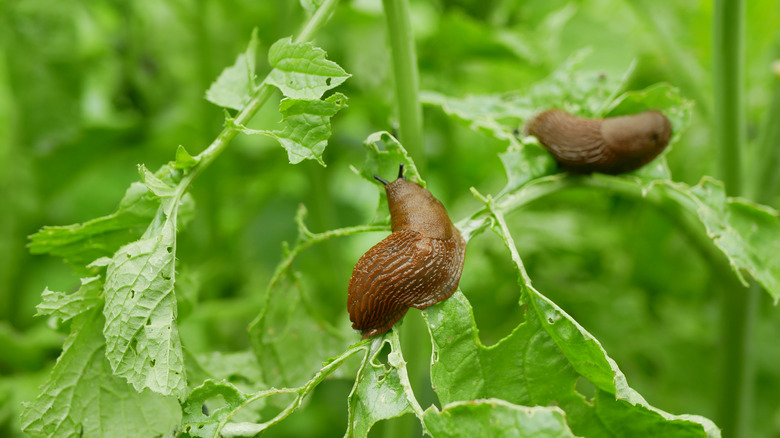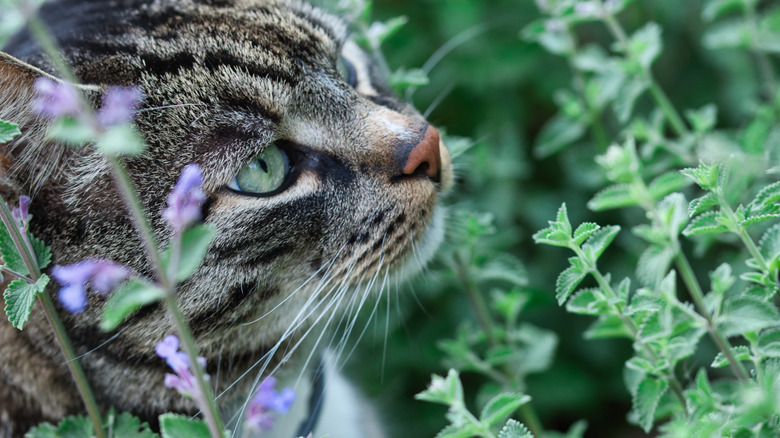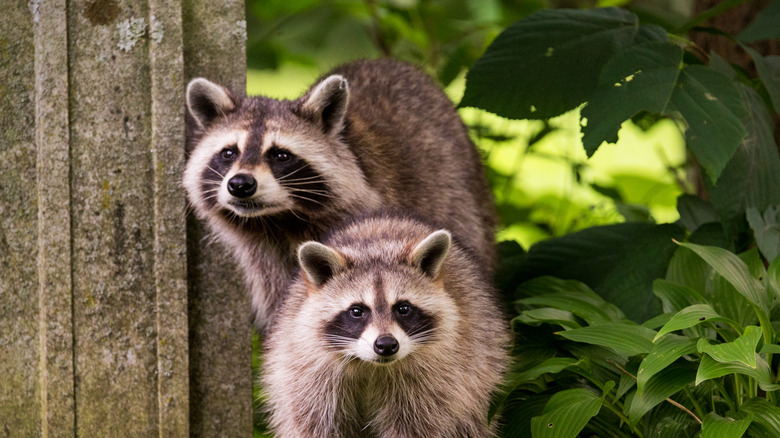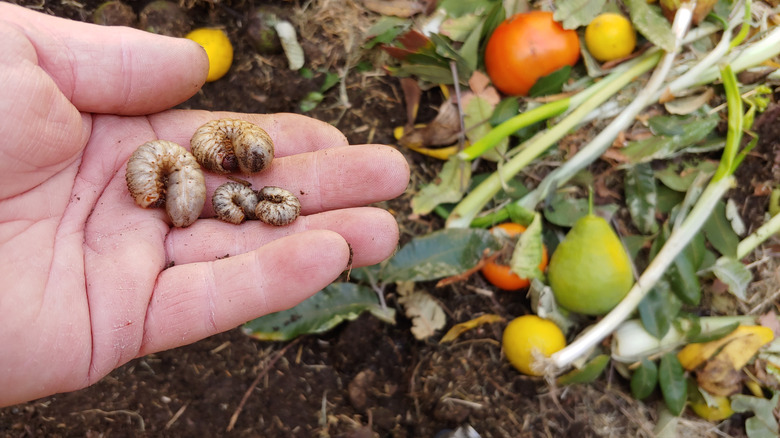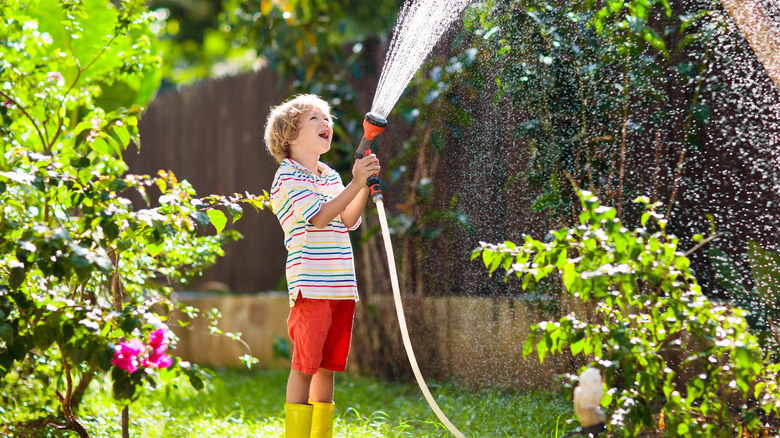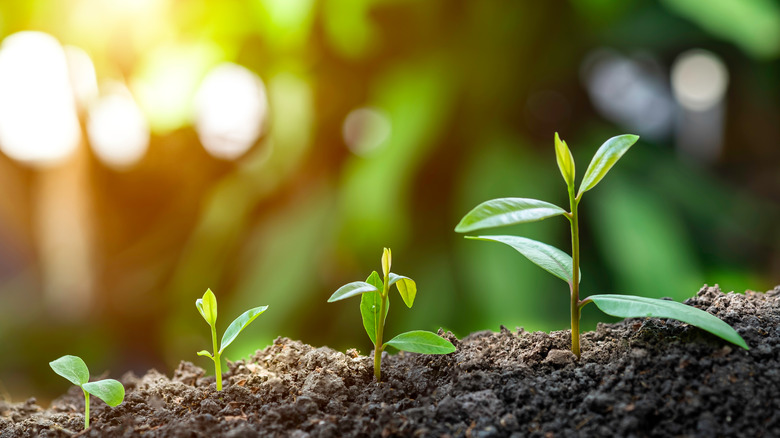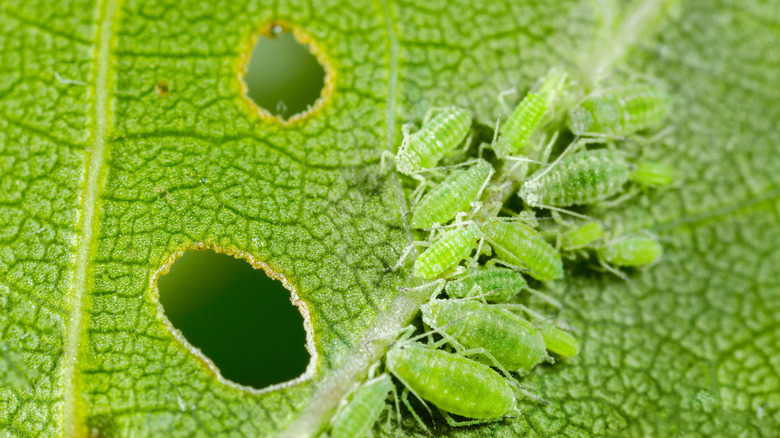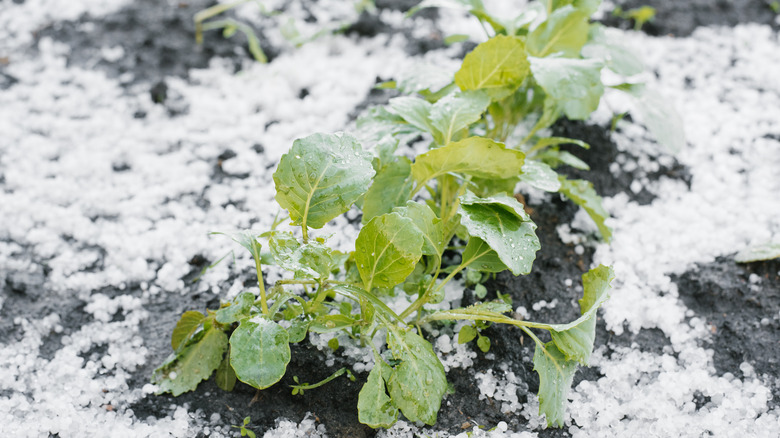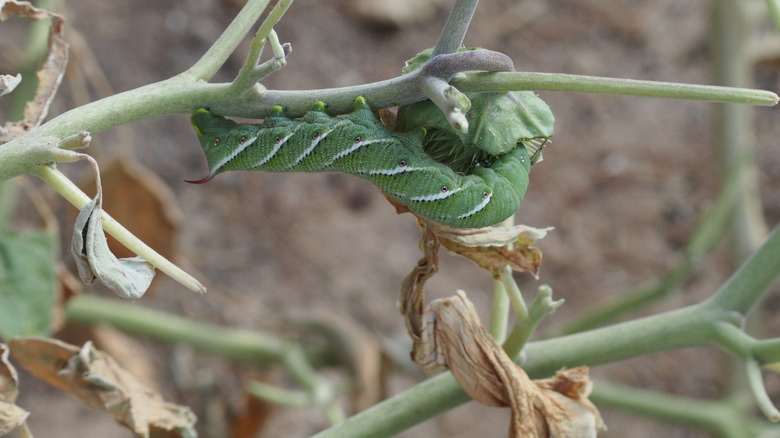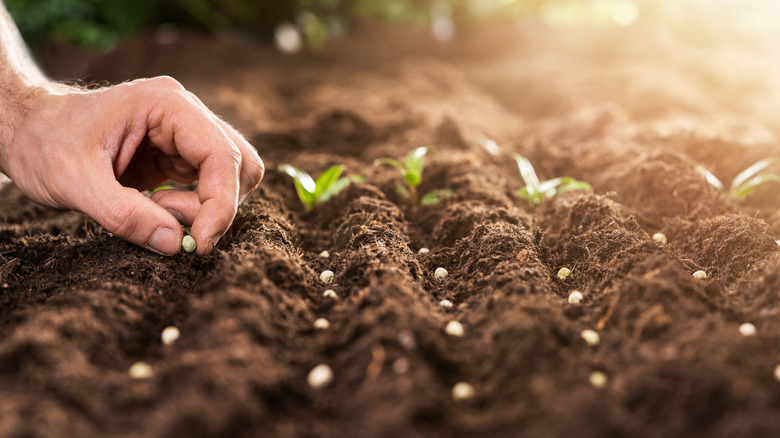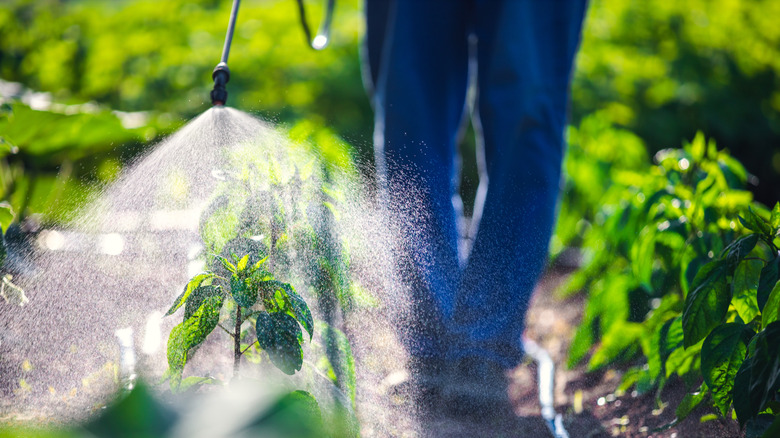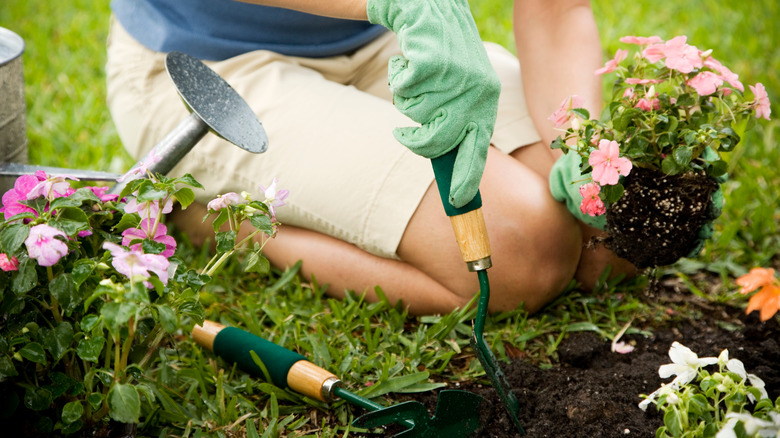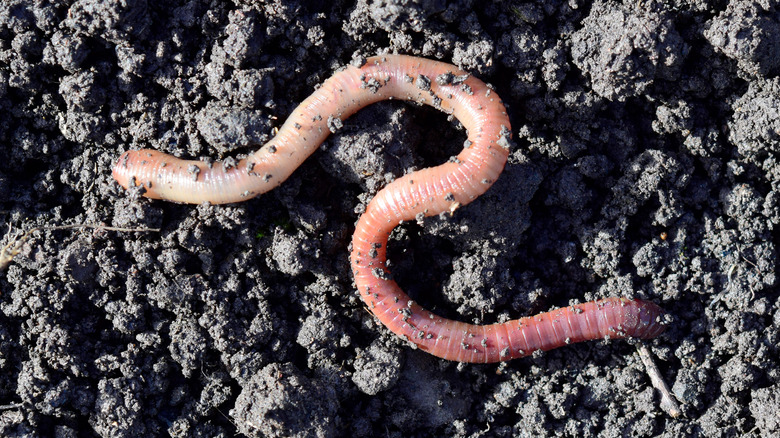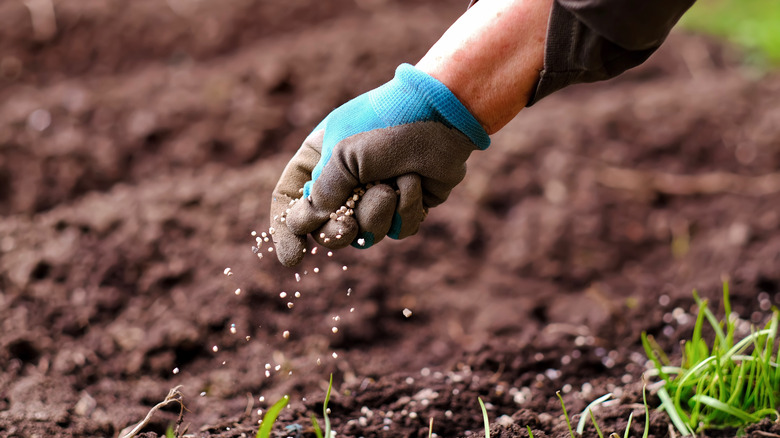Hidden Dangers That Are Ruining Your Garden
Since the start of the pandemic, homeowners and renters alike have been looking for new ways to get the most out of their homes — including their yard space. One hobby that experienced a major boost in popularity was gardening, according to The Guardian, with seed sellers reporting a massive increase in demand. While it may have been a passing fad for some, a new generation of gardeners has discovered the joy of plant care and the satisfaction of growing their own fruit, vegetables, and ornamentals.
While gardening can be an extremely rewarding pastime, it's also an opportunity for major disappointment. There are few experiences more frustrating than coming outside to see that a plant that you've painstakingly cared for has wilted overnight or been ravaged by insects. To that end, maintaining a garden involves more than just watering, weeding, and ensuring your plants get the proper amount of sunlight. There are numerous factors that need to be taken into account if you want to see your garden flourish and enjoy the fruits of your labor. Here are some of the biggest hidden dangers that threaten your plants and how to navigate them as you continue to refine your green thumb.
Hungry slugs can eat through your garden
These terrestrial mollusks have developed a bad rep in the gardening community, but it's not their unsavory secretions that you need to worry about — it's their appetites. Garden slugs come in all shapes and sizes, but the one thing they all share is an undiscerning palate. According to Gardening Know How, slugs will gladly chow down on just about anything green and leafy, as well as any fruits and vegetables they can find. If given their pick of the menu (e.g. your garden), slugs are most likely to target tender leaves. This makes them an especially significant threat early in the growing season when your plants are still vulnerable. As the season progresses, their attention shifts to fruits and vegetables. Should slugs take up residence in your garden, your homegrown produce risks being consumed long before you get to taste it.
Thankfully, there are many tried and tested methods for keeping slugs away from your precious plants. After planting seedlings, it's important to create physical barriers between your plants and any hungry slugs, such as broken eggshells and sand, which irritate their sensitive flesh. You can also draw slugs away from your plants with various forms of bait, like beer or fresh fruit. The good thing about slugs is that, unlike smaller pests, they're fairly easy to spot. Check the damp corners of your garden regularly and physically remove slugs to keep the population under control.
Cat feces can carry disease
To a cat, your beautiful garden looks like one big litter box, a cozy oasis complete with natural coverage to give them some privacy while they do their business. Now, different types of animal feces have long been used to help our gardens thrive. Unfortunately, cat feces isn't an ideal fertilizer — but the basic materials that make up cat poop also aren't doing any harm to your plants. The problem with cat feces in the garden is the risk of unwanted bacteria and parasites that could be lurking within, per The Morning Call.
Cats have been known to carry a variety of worms that can be transmitted to humans, including hookworms, tapeworms, and roundworms. Though such instances are rare, cat feces can also contain toxoplasmosis. For people with immunodeficiencies and small children, this presents a significant health risk and can even lead to miscarriages in pregnant people. So it's important to be diligent in checking your garden in case any local cats have taken a liking to it. If you find cat feces in your garden, wear gloves and a face mask when handling the waste material, and be sure to thoroughly wash your hands afterwards. If the feces came in direct contact with any produce, dispose of it. Should this become a recurring problem, consider building a chicken wire frame around your garden to keep the cats out.
Wild animals mean big trouble for your garden
Certain creatures, like snakes and frogs, are actually natural predators of slugs. Because they pose no threat to your plants, they make great allies in the quest to keep your garden pest-free, according to The Oregonian. Sadly, the same cannot be said for most mammals that are likely to come calling; squirrels, chipmunks, rabbits, and raccoons are all scavengers by nature. As soon as your garden starts yielding tasty fruits and vegetables, the local wildlife is likely to take notice. Tunneling mammals like groundhogs and moles are especially troublesome because they can actually access your garden underground, circumventing most of the protections commonly put in place against the aforementioned critters (via Gardener's Supply Company).
Properly protecting your garden from wildlife starts with identifying the culprits so you can come up with an appropriate solution. Depending on the habits of the specific pests, you'll want to make adjustments around the home to discourage them from taking up permanent residence in the surrounding area. Shut off access to favorite raccoon hideouts like crawl spaces and make sure your garbage is secure — as your garden alone is unlikely to be big enough to serve as their sole food source. If the problems persist, you may need to invest in fencing or traps. Reflectors, noise-makers, and having a pet on-site (like a cat or dog) are also effective deterrents.
Cutworms go for the kill
As the name suggests, cutworms are not satisfied to simply munch on a few leaves; they prefer the crunchy stems of your plants and can therefore devastate a fledgling garden in record time as they topple your seedlings. There are a number of different types of cutworms that vary in size, color, and habits. According to the University of Minnesota, black and bronze cutworms find the plants they like and will then return nightly to target new growth. Glassy cutworms, which are more of a translucent, silvery-white color, prefer to attack from ground level, targeting the stems at their base or even tunneling down into the roots. Every type of cutworm has their own unique style, but the one thing they all share in common? They're bad news for your garden.
The key to protecting your plants from cutworms is to identify the problem early. Most cutworms work at night, but their handiwork is easy to spot the next morning. During the day, they retreat to the foliage, becoming more active as night approaches. Once you've confirmed you have cutworms (tip: they curl into a C shape when bothered), remove as many of them as possible from the garden and get rid of the loose plant debris where they like to nest. Last but not least, place small barriers around the base of your plants to cut off access to their food supply.
Overwatering hurts your garden
Too much of a good thing is actually a bad thing, and this is certainly true when it comes to watering your plants. Your garden is often bringing together plant species from different environments and climates. In order for them to flourish, you need to give them the right mix of sun and water to bring them as close as possible to their natural environment, advises Treehugger. When it comes to water, too much and your plants risk becoming oxygen-deprived as a result of oversaturated soil and root damage. This can be an issue of both quantity and frequency. Plants don't like being overwatered in a single session, but they can also suffer from being watered too often.
You already have many external factors to worry about when it comes to dangers in your garden. Thankfully, this one is completely within your control. Still, it can sometimes be difficult to know whether you're overwatering or underwatering your plants, given that both reveal themselves through wilting. When you're underwatering, however, your leaves will tend to dry out and get crispy, while overwatered leaves will be more limp and flimsy. To avoid overwatering your plants, water them less frequently and assure that you're getting water deep enough to encourage root growth. Proper drainage is essential, as is pairing plants that need similar amounts of sun and water.
Watering at the wrong time of day is a factor
Hydration is key to maintaining good health — for both gardens and gardeners. When a heatwave hits, gardeners working in the hot sun will want to take regular breaks and ensure that they are drinking plenty of water to avoid dehydration or heat exhaustion. When it comes to your plants, however, things get a bit more complicated. In extreme heat, moisture evaporates quickly, potentially throwing off your watering schedule and leaving your plants at risk of drying up, as noted by The Conversation.
Your instinct is likely to water your plants in the afternoon when the temperature is at its most intense in an attempt to cool them off. The issue with this approach is that the hot sun actually dries up much of the water before it properly penetrates the soil and is absorbed by the roots. The end result is that while you're giving your plants their regular quantity of water, they're only absorbing a fraction of it. Additionally, gardeners will often give their plants more water to make up the difference, but this can easily lead to overwatering. Ideally, you should instead water your plants in the morning or early evening when the heat is less intense and the roots have more time to absorb the appropriate amount of water.
Aphids target new growth in your garden
Small, green, and seemingly harmless, aphids are easy to overlook. In fact, at less than a quarter-inch in size, you might not notice them at all until you take the time to really inspect your garden. However, these tiny terrors should not be underestimated, as a group of them can topple even the most bountiful of gardens if left unchecked. Aphids are particularly drawn to new growth when it's easiest for them to access what they're after: the nutrient-rich sap inside your plants. The miniature menaces drain your garden of the essential liquids they need to thrive and develop healthy new growth.
Aphids are often indiscriminate in the plants they target, which can lead to widespread damage once they've established a sizable population in your garden. To make matters worse, they can also develop wings that allow them to expand their territory to new plants. Thankfully, there are a number of low-effort ways to deal with aphids. The simplest solution is spraying them with cold water, which dislodges and disorients the insects. Once grounded, they struggle to climb the plant again. Sprinkling affected plants with flour is another tactic, which works by constipating the insects. If neither of the above methods proves effective, combine water, a bit of soap, and cayenne pepper and apply it to your plants with a spray bottle, per The Old Farmer's Almanac.
Severe weather can wipe out vulnerable plants
The weather can cause problems in your garden in more ways than one. No matter how careful you are with your watering, a rainy week or a single serious downpour can wreak havoc on plants that prefer a dryer climate. Strong winds, hail, and dry spells all pose serious threats to the health of your plants. A responsible gardener should always keep an eye on the weather and plan ahead. While weather can be unpredictable, having contingency plans for the most common forms of extreme weather can save you from having to completely restart your garden. This is never more true than when you're dealing with seedlings that have yet to develop the structural integrity needed to survive intense conditions.
When it comes to heavy precipitation, hail, or strong winds, covering your garden is a great way to diminish the impact of the elements. Cover your plants with a material like burlap or landscaping fabric to keep them out of harm's way. If you're using planters that can be moved, all the better. When a storm is coming, place them under a sheltered area. Some plants can even be protected with a hard outer shell like an upturned bucket or empty flower pot. In the event of drought, make sure to water regularly in the morning or evening, while flooding will require extra attention in terms of drainage and wiping down mud-soaked leaves, according to Farmer's Almanac.
Tomato hornworms love tomatoes
An insect doesn't wind up with a specific type of produce in its name unless it's formed a serious attachment to the plant. As tomato growers know all too well, these large green caterpillars can grow up to five inches long and have appetites to match their size. If left unchecked, tomato hornworms can completely strip a tomato plant of its leaves while also creating large holes in the unripened fruit, warns GrowVeg. As if that's not bad enough, hornworms will also chow down on potatoes, peppers, and eggplants, meaning that depending on what you're growing, a sizable chunk of your garden could be at risk once a population is established.
Hornworms are almost the exact same shade of green as a tomato plant, but their size makes them relatively easy to spot. The adult caterpillars can easily be handpicked from the tomato plants. Eggs and larvae are slightly more difficult to find, as they tend to hide under leaves, so you'll want to be diligent when inspecting your plants. The larvae is known to overwinter in the soil, so it's important that you till your garden at the beginning and end of the season as a preventative measure.
Overcrowded plants are unhappy plants
As gardeners, we have to contend with a lot of hidden dangers that target our plants; that's why it's important to set your garden up for success by giving it the best possible starting conditions. If you're working with limited space, it can be tempting to try to squeeze in as many plants as you can, but a garden can't prosper when overcrowded, explains SF Gate. When you pack too many plants together, they compete with their neighbors for water, nutrients, and sunlight. The end result is that none of the plants grow to their full potential. Some may even wind up getting choked out altogether, while overcrowding can also increase the likelihood of fungal infections and pest problems.
Every plant has its own unique spatial needs depending on the way it grows — both below and above ground. Always research the specific plants you'll be growing and verify the recommended space they need for proper growth. If you're looking to maximize your garden space without compromising on the health of your plants, consider trying out one or more intensive gardening methods. These include grid-like gardens divided by square foot, as well mixing and matching companion plants that grow well together while using up less space. If you're working with limited space, you can also take a bio-intensive approach, focusing on the soil to maximize the output of each plant.
Herbicides should be used with caution in your garden
You put a lot of time and energy into designing your garden and making every square foot count. Seemingly overnight, however, unwelcome weeds sprout and start stealing valuable resources from your carefully tended plants. Well, weeding is an unavoidable part of garden maintenance that, while frustrating, is simply part of the process. The temptation to embrace a chemical solution is high, but herbicides should be used sparingly. If you decide to go the chemical route, you'll want to first confirm that the product can safely be used with all of the plants you've chosen, as noted by the University of Georgia.
When using an herbicide in your garden, you'll want to plan ahead and use a pre-emergent herbicide. These are applied to the garden immediately after you've planted your seedlings but (hopefully) before any weeds have had the opportunity to take root. You simply mix the herbicide into the top half-inch of soil and, once activated, the herbicide will act as a barrier. However, be advised that the wrong types of herbicides can be harmful to humans, animals, and the environment. For this reason, it's worth considering non-chemical alternatives like mulch or fabric barriers to achieve a similar effect.
Improper care of garden tools
We're often so focused on the plants and pests in our gardens that we don't give much thought to the tools we're using. Your pruning shears, garden fork, trowel, spade, and hoe are coming in direct contact with the soil and plants in your garden. As such, according to The Spruce, they need to be properly cared for. Cleaning your gardening tools after each gardening session is a good habit to get into that helps reduce wear and tear, identify rust, and reduce cross-contamination between plants and planters. Your tools should be rinsed off, soaked in soapy water, rinsed, and then dried before being stored.
The above process applies to general gardening sessions. If you're dealing with pests or unhealthy plants, however, you'll want to be disinfecting your tools as often as possible. Under no circumstances should tools be used on an infected or infested plant followed by a healthy plant, as this significantly increases the likelihood of cross-contamination. The same applies for planters and pots that you use for gardening. They should be emptied and thoroughly cleaned before being used with a new plant to avoid any lingering threats.
The wrong kind of worms can harm your garden
Worms are a gardener's best friend. The presence of these creepy crawlers is a telltale sign of a healthy garden, meaning that, according to the University of New Hampshire, you don't generally need to go out of your way to introduce them to the soil. Once they arrive, they make a number of positive contributions in the form of their tunneling and excrement. When they burrow, worms aerate the soil, improving both water absorption and oxygen, while worm castings provide great nutrients for your plants.
While most types of earthworms are a welcome sight in the garden, there's one species that you need to watch out for: the jumping worm, warns the University of Illinois. Also referred to as the Alabama worm or snake worm, this invasive species is identified by the violent way they thrash whenever disturbed or handled. This unwelcome creature has become a major problem across the United States, where they've had a significant negative impact on forest health. In the home garden, they're known to deplete soil quality and cause root damage as their castings make up an increasingly large percentage of the soil. If you spot jumping worms in your garden, it's important to remove them whenever possible. Mulching and additional fertilization are also recommended.
Over-fertilizing can be too much of a good thing
Speaking of fertilizer, while this nutrient-rich soil additive is great for plant health, it needs to be used in moderation. Fertilizer is a way to add much-needed nutrients to your garden to keep your plants healthy and growing strong. As your plants pull nutrients from the soil, fertilizer serves to replenish your planting medium and ensure that your earth remains fertile. When too much fertilizer is added, however, it negatively affects the plant's ability to absorb water, cutting them off from nutrients in the process, per Jain.
Over-fertilizing can actually be quite difficult to identify for this very reason; the signs of over-fertilizing include yellowing leaves, decreased growth, and root rot — all of which can also be said of a plant that has been overwatered. The difference is that compared to overwatering, the symptoms of over-fertilizing show themselves much faster after adding the fertilizer to the garden. If you've over-fertilized, heavily water the garden to help flush some of the fertilizer out of the root zone. Excess fertilizer will often form a crust at the top of your soil, which should also be removed. Most importantly, however, you should never exceed the recommended amount of fertilizer on the packaging.

